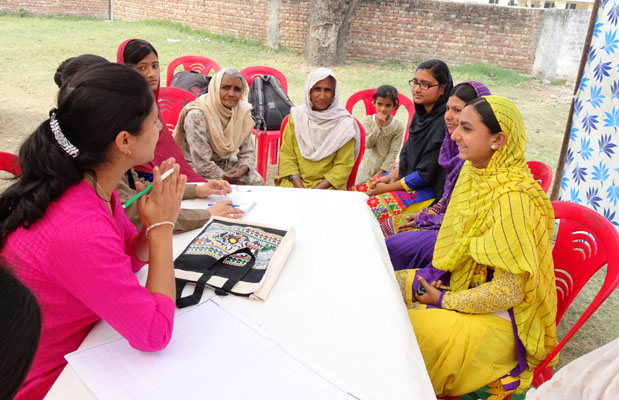By Divya Sharma
 Consultation with women stakeholders in Hakeempur village, Uttrakhand
Consultation with women stakeholders in Hakeempur village, Uttrakhand
Hakeempur Turra is a flood plain village. It sits on the bank of the Solani River, a tributary of the mighty Ganga. It was here that India’s first aqueduct was built in 1854. The village is close to the urban settlement of Bhagvanpur and, the educational hub of Roorkee. I happened to be a part of research group which visited Hakeempur Village recently as part of a HI-AWARE Academy field study. We reached the village by bus, and as planned, divided ourselves into three groups and waited for the villagers to join us for the planned activity. To our surprise, not a single woman turned up. The chairs started to fill up with male members of the village. This was in contrast to previous field visits I had made in the mid- and high- elevation regions (Tehri Gardwal, Rudraprayag) of the Upper Ganga in Uttrakhand.
After we had waited a while, two female Aganwadi (a village day-care facility) workers came, but they left without getting involved as soon as they realised they were the only woman representatives. When I asked one of the villagers why the local women were not participating, he replied, “They would not have known about the meeting.” That casual remark had a deeper connotation: It pointed towards the existence of rigid gendered conformism in the village and the region.
After a while, a group of young women came with their grandmothers and sat around a different table, away from the men folk. Anju (Ms. Anju Pandit, ICIMOD) and I stood up from our assigned table to join them and understand their perspectives. During a spontaneous conversation with them, when we were trying to understand the village and its culture, a very peculiar variable about higher education and college dropout rates surfaced. One of the participants told us that girls attend near-by colleges in groups. If one or two of the girls drop out for some reason, the rest of the girls stop going to college as well. The campus is located far from their village and it’s not safe to travel alone or in smaller groups. The ‘group’ is very important to them especially if they are to remain within the formal education system.
As we were sharing experiences with the other sub groups, Dr. Bhatt (From SHARD, Rudraprayag) revealed that young men in the village were very happy with the educational options available in the vicinity and that they had no problems regarding the commute as many of them owned motorbikes.
To understand the problem I searched for colleges nearby Hakeempur Turra on Google Maps. On it, more than 10 colleges are listed as being within a driving distance of 10-20 minutes.
 Google Map for colleges nearby Hakeempur Turra village
Google Map for colleges nearby Hakeempur Turra village
Prior to the field activity, in one of the sessions conducted by Dr. Chanda Gurung Goodrich, we had learnt about gender being a social construct, and in the field, we saw the manifestation of that social concept.
One kilometre stands for the exact same measure of distance in the whole world. But in this village, it stands differently for women and men. In Hakeempur, the distance to college is not measured in kilometres or miles but it terms of perceived safety and approachability, which are dissimilar factors for the different genders.
Our short conversation with the young women of Hakeempur Village, reemphasised two things. First, that different people have diverse perceptions regarding the same situation and that they comprehend it differently. Second, that in the exact same situation, an issue for one can be a non-issue for another.
For a researcher, this creates layers of complications. What issue to pick, and conforming to what world view? Can we create a whole with the sum of parts of these different world views?
No matter how objectively we start, the outcome will also affect these different world views differently.
So here is a challenge and an opportunity. Can we be innovative enough to embed the adaptation option in a social mesh that will not only work for the necessity it has been targeted at but also strategically work for the equity of women and the marginalised from that society? As we say in Hindi Ekpanth do kaaj (one can achieve two different goals even when walking on a single path).
